Do you have a sloped garden and don’t know what to do with it? Don’t worry, you’re not alone! A sloped garden can be a challenge to landscape, but it’s definitely not impossible. This article will provide some tips and ideas for transforming your sloped garden without breaking the bank. So, whether you’re looking to create a beautiful outdoor space for entertaining or simply want a place to relax, read on for some inspiration!
What are Sloped Gardens?
Sloped gardens are landscaped areas situated on sloping or hilly terrain. These gardens feature a variety of plants and other features that have been carefully designed to take into account the inherent challenges posed by such landscapes. For instance, terracing may be used to create flat areas for planting, while retaining walls can help to prevent soil erosion.
Planting beds, hardscaping features, and even water features can be incorporated into the design of a sloped garden to create an attractive and functional landscape. Additionally, careful consideration should be given to the drainage requirements of such gardens as slopes are typically more prone to runoff than flat areas. With proper planning and creative design, however, these gardens can be transformed into beautiful, unique spaces.
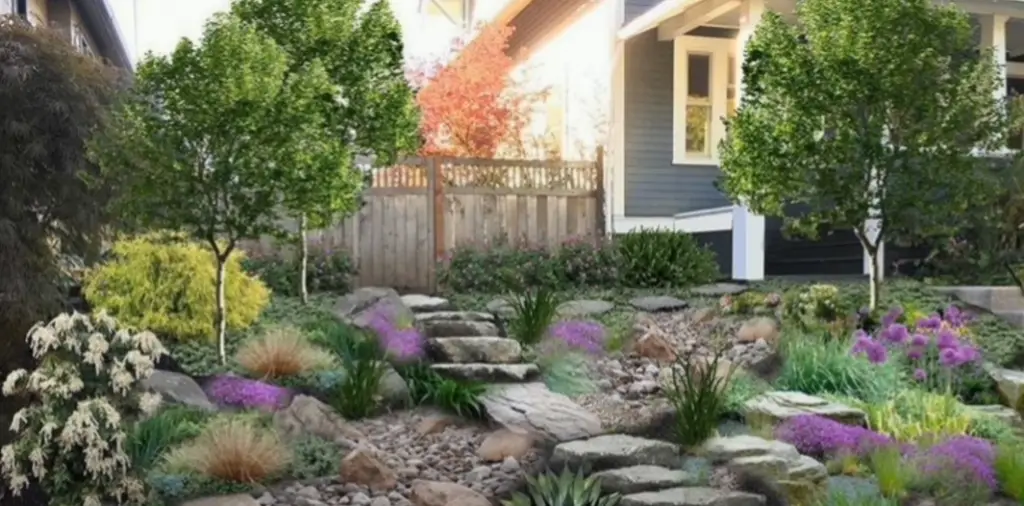
Advantages of Sloped Gardens
One of the primary advantages of sloped gardens is that they offer a great deal of visual interest and impact with relatively little effort. In addition to the variety of plants and features that can be incorporated into the design, the natural slope itself can be used to create dramatic effects, such as tiered flower beds or cascading water features.
Finally, sloped gardens provide an opportunity for gardeners to make use of otherwise unutilized space. Rather than simply grading over the slope, these gardens can be creatively designed to maximize the potential of the area [1].
Disadvantages of Sloped Gardens
One of the key disadvantages of sloped gardens is that they require a greater degree of maintenance than flat terrain. Due to their susceptibility to soil erosion, sloped gardens must be closely monitored to ensure that the soil is kept in place and the plants are sufficiently hydrated. Additionally, the steeper slopes may require more frequent mowing or other maintenance.
Additionally, sloped gardens can be more difficult to access, requiring the use of steps or ramps to reach certain areas. This can make it challenging to manage and maintain these gardens without considerable effort.
Finally, sloped gardens may require a greater investment in time, materials, and money than flat-terrain gardens. The terracing and retaining walls required for these landscapes can be expensive and time-consuming to construct. Additionally, depending on the steepness of the slope, more plants may be needed to cover it adequately.
Best Sloped Garden Ideas on a Budget
Go for Ground Covers
Ground covers are a great way to keep weeds away and add texture to your sloped garden. Many different options can be chosen, depending on the soil type and climate of your area. Examples include creeping thyme, Irish moss, vinca minor, or even sedum ground cover varieties.
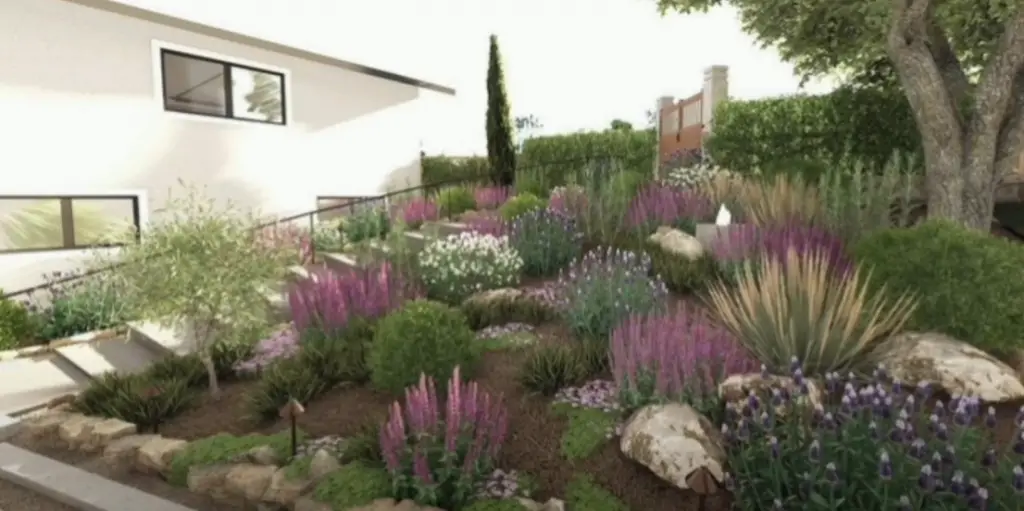
Build Raised Beds
Raised beds are a great way to add dimension and color to your sloped garden. They can be filled with soil that is amended with compost or fertilizer for the perfect growing environment for flowers, vegetables, or herbs. You may want to consider building retaining walls or terraces around the raised beds as well to help hold them in place.
Add a Pathway
Adding a pathway to your sloped garden can add interest and allow you to access hard-to-reach areas with ease. A gravel or mulch path will provide traction, while a flagstone path can create an interesting visual effect. Planting around the edges of the walkway can help hold it in place and add beauty.
Make use of Natural Stones
Using natural stones can add texture and depth to your sloped garden. Larger, heavier stones work well for retaining walls or as an edging material, while smaller stones can be used to create a rock garden. Try mixing and matching different sizes and shapes of rocks to create a unique landscape feature.
Build a Natural Rock Garden
If your sloped garden is really steep, consider building a natural rock garden. This type of garden will make use of small stones and boulders to create a terraced look that offers plenty of planting options. You can also add water features like fountains or ponds for an added element of tranquility.
Plant Low Maintenance Plants
When it comes to planting on a sloped garden, going for low-maintenance plants is the way to go. Consider drought-tolerant ground covers like sedums or succulents, which require minimal care and attention. You can also add evergreen shrubs or trees that don’t need much water or pruning.
Install Vegetable Gardens
If you’re looking for an easy and practical way to make use of a sloped garden, consider installing a vegetable garden. This will not only add color and texture to your landscape but also provide a source of fresh produce for you and your family. You can even create a raised bed system with retaining walls or terraces to make it easier to tend to your garden.
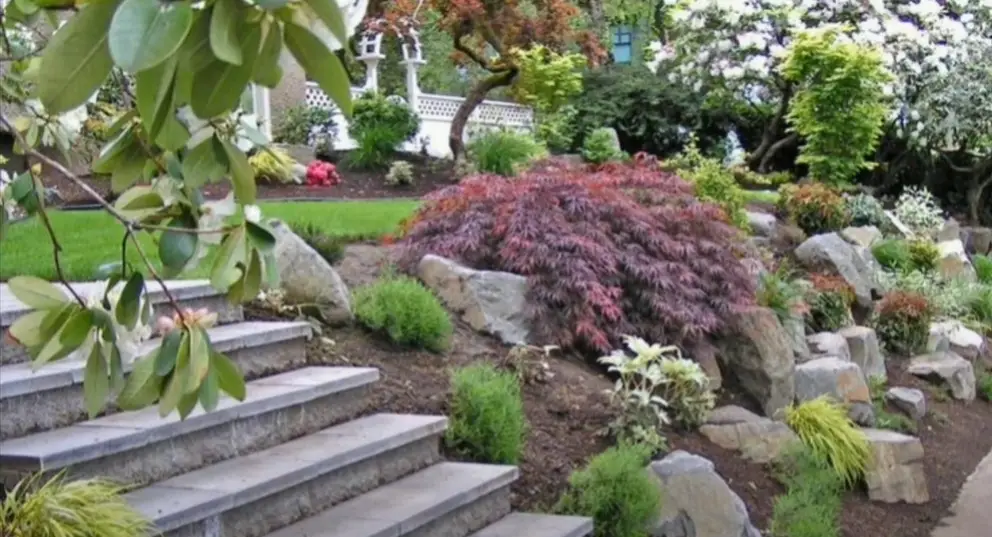
Make use of Hanging Baskets
Hanging baskets are a great way to add color and texture to a sloped garden without taking up too much space. You can choose from a variety of plants, such as flowers, herbs, or even vegetables like tomatoes or squash. Just make sure the baskets are securely attached to the wall or fence and have proper drainage.
Make Use of Watering Cans
Watering cans can be used to water your plants and help keep them healthy. If you have a sloped garden, it’s especially important to use a watering can as it will allow you to direct the flow of water precisely where it’s needed. This will help ensure that each area of your garden receives the proper amount of moisture.
Sloped Backyard Seating Area
If you have a sloped garden, why not make use of the space and create an outdoor seating area? You can add a few chairs or benches and include some comfy cushions for added comfort. This will provide the perfect spot to sit back and relax while enjoying your garden.
Polished Wood Steps
Adding polished wood steps to your sloped garden can make it easier to access hard-to-reach areas. It will also provide an attractive feature and add a touch of style to the landscape. Choose from a variety of woods, such as cedar or redwood, for durability and long-lasting beauty.
Create Retaining Walls
If your sloped garden is really steep, you may want to consider building retaining walls. This will help keep the soil in place and also create an interesting feature that can be used for planting or seating areas. Choose from a variety of materials, such as stone, brick, or wood, to create the look you desire.
Tumbled Patio Pavers
Adding tumbled patio pavers to your sloped garden can create an attractive feature and provide a durable path for walking. Choose from various shapes and sizes of pavers, such as flagstones or cobblestones, for a unique look that will enhance your landscape design.
Small Waterfalls
If your sloped garden has a natural spring, why not turn it into an attractive feature by adding a small waterfall? This will create a tranquil sound as the water cascades down the rocks and provide additional interest to your landscape. Just make sure you have proper drainage in place so that the water doesn’t flow into your home.
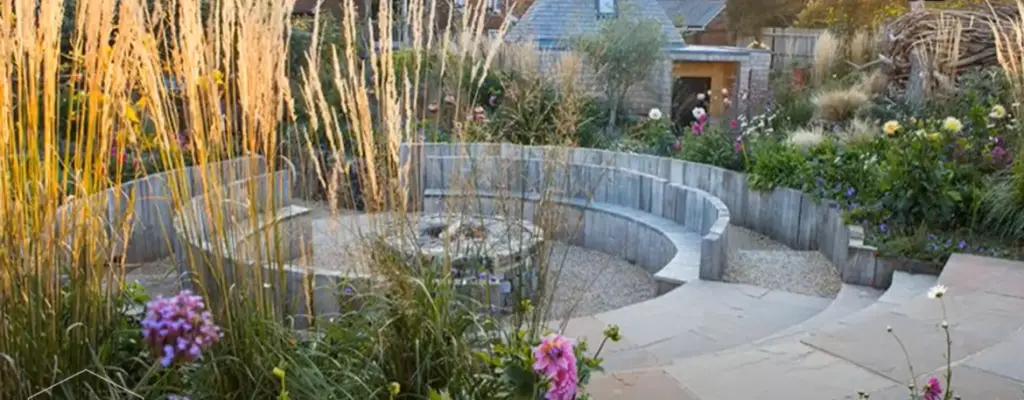
Use a Slide
Turn your sloped garden into a fun area by adding a slide. This will provide hours of entertainment for both kids and adults alike. You can even add a few trees or shrubs in the area to create an obstacle course that can be used for an added challenge.
Have a Destination Fire Pit
Adding a fire pit to your sloped garden can provide many benefits. It will give you a place to gather with family and friends and make s’mores, as well as provide warmth on chilly evenings. Just make sure the area is secure and away from any potential hazards.
Native Plants
Finally, consider adding native plants to your sloped garden. This will help attract local wildlife and provide a source of food for them. It will also ensure that the plants are well-suited to your particular climate, making it easier to care for them over time. Choose such plants as wildflowers, grasses, shrubs, and trees to create a colorful and inviting landscape [2].
How to create Sloped Gardens?
Creating a sloped garden can be an enjoyable and rewarding experience. It requires planning, patience, and creative problem-solving skills to build a successful sloped garden. Here are the steps you should take when creating your own:
- Start by evaluating the space you have available for your sloped garden. This will help you determine the type of plants and materials you can use.
- Create a design plan that includes a variety of terraces, walls, or other raised areas to make the most of the space and maximize drainage. You may also want to consider adding seating or paths for easy access.
- Consider using drought-tolerant plants in your design to reduce the water needs of your garden.
- Install a base layer at the bottom of the slope, such as an erosion control fabric or gravel, to help keep soil and nutrients in place.
- Add a mix of organic matter (compost, mulch, manure) and mineral amendments (grit, clay) to the soil to help improve drainage and aeration.
- Plant your chosen plants and trees, taking care not to overcrowd them so they have enough space to grow.
- Build raised beds or containers if needed for additional support or drainage capabilities.
- Add a layer of mulch or topsoil to help retain moisture and reduce weeds.
- Water your plants regularly and mulch around the base of each plant to help conserve water.
- Finally, enjoy your new sloped garden!
With a bit of planning and creativity, you can create a beautiful outdoor space that adds value and enjoyment to your home [3].
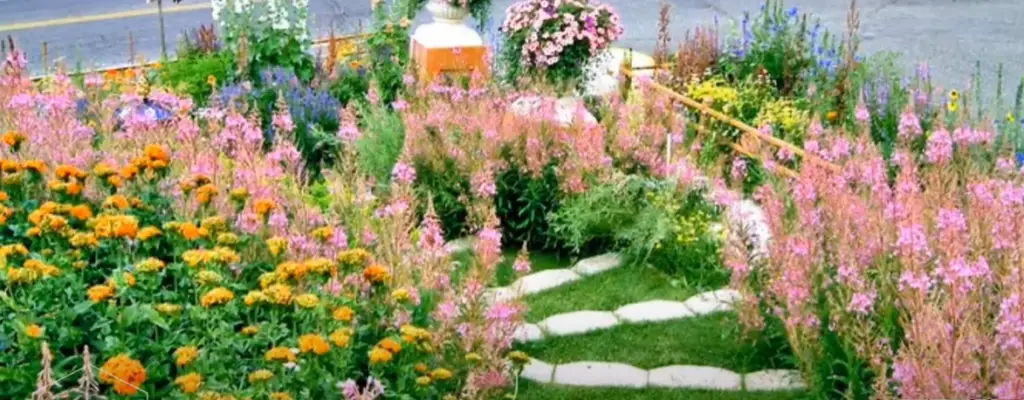
Other popular designs for home gardens
Apart from the above designs, there are other popular home garden designs that you can consider when setting up your own garden. One idea is a Japanese-style garden, which uses rocks and sand to create a calming atmosphere. These gardens often feature low trees and shrubs, as well as statues or figurines that represent animals such as deer or birds. You can also add water features such as streams or ponds for an even more relaxing atmosphere.
Finally, a tropical garden can add a touch of the exotic to your backyard. This style relies heavily on plants to create an atmosphere, with bold colors and lush foliage adding to the overall look and feel. Tropical plants such as palms, bananas, and bougainvillea are great choices for this type of garden. Whatever style you decide to go with, remember that adding personal touches will make your garden unique and inviting!
How to maintain gardens?
Gardening is an art, and like any other art, it requires maintenance to keep the garden looking its best. Maintaining a garden can seem like a daunting task but with some basic knowledge and proper planning, anyone can learn how to maintain their garden.
First and foremost, fertilizing your plants regularly should be part of your gardening routine. Fertilizer helps replenish the nutrients in the soil that are used up by plants as they grow. Different types of fertilizers are available for different types of plants so make sure you select the right type for your specific plants.
Another important aspect of maintaining a garden is pruning. Pruning not only helps keep your garden looking neat and tidy but it also helps plants grow healthier. Make sure to prune your plants in the right way so as not to damage them and always use clean, sharp tools for best results.
Weeding is also a key part of garden maintenance. Weeds can compete with your plants for space and resources so it’s important to keep on top of the weeds in your garden. Manual removal is usually recommended, but there are also chemical solutions available if you prefer.
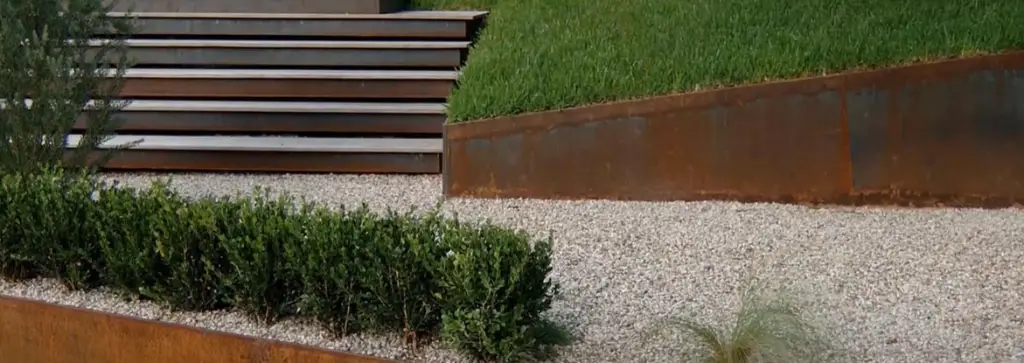
Finally, watering is essential for keeping your garden healthy and happy. Different types of plants require different amounts of water so make sure you research how much water each type needs beforehand and adjust accordingly. Additionally, mulching can help retain moisture in the soil as well as reducing weeds, and providing nutrients to your plants.
Maintaining a garden can seem like a lot of work but with some knowledge and planning, it doesn’t have to be too difficult. With the right care and maintenance, your garden will stay looking beautiful for years to come!
What do you need for creating a sloping garden?
Creating a sloping garden can be a challenging task, but with the right tools and materials, it is possible to create an attractive and functional outdoor space. The following list outlines some of the key components required for creating a sloping garden:
Topsoil: To give your plants and grasses a nutrient-rich foundation for growth, you’ll need topsoil. Topsoil should be free from stones, weeds, and other debris that could inhibit plant growth or cause instability on slopes.
Mulch: Applying mulch to your slope will help retain moisture in the soil while also preventing erosion. Not only is it aesthetically pleasing, but it can also provide valuable nutrients to your plants.
Plants: To prevent erosion, a sloping garden requires tough, hardy plants that can withstand the elements and survive in dry conditions. Planting ground cover or grasses along the slope is an effective way of stabilizing it while also adding color and texture.
Grading tools: To create an even surface on a sloping garden, you will need the right tools for grading. This includes shovels, rakes, hoes, and other hand tools that are designed to level out soil when creating a slope.
Retaining wall materials: Depending on how steep your slope is, you may need to build a retaining wall to contain the soil and create a more level surface for your plants. The materials you will need for this include bricks, stones, concrete blocks, and other masonry materials.
Drainage: Good drainage is key when creating a sloping garden as it prevents waterlogging and can help protect against plant disease. To achieve this, you’ll need to install drain pipes or tiles to channel away excess water from the slope.
By ensuring that you have all of these components on hand before beginning work on your sloping garden, you will be able to create a successful outdoor space that looks great and functions properly. With some dedication and hard work, your slope will soon be transformed into a beautiful garden oasis!
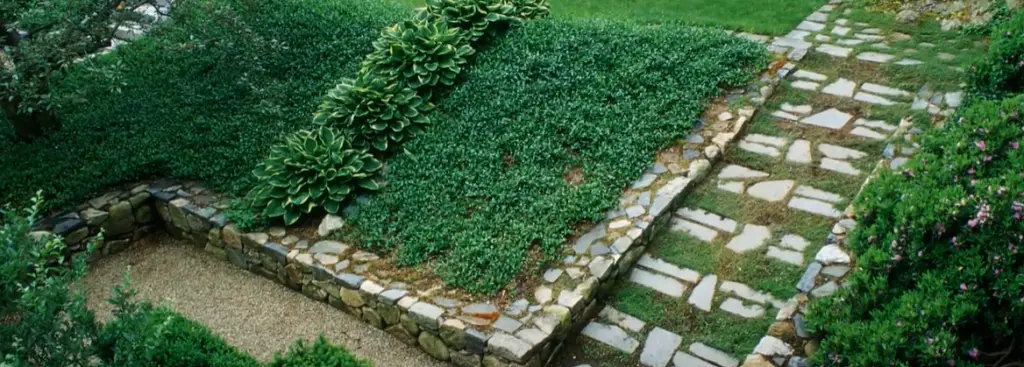
FAQ
What is the best landscaping for a slope?
The best landscaping for a slope depends on the specific needs of your landscape. If you are looking to reduce erosion, terracing or building retaining walls may be your best option. If you want to create a more natural look, adding plants and trees that fit the local environment can help slow down runoff and improve soil stability. There are also hardscape solutions such as steps, gravel pathways, or decks that can provide an attractive way to navigate up and down the slope. Ultimately, it is important to consider both form and function when deciding on the right solution for your project.
What can I do with a slightly sloped backyard?
A slightly sloped backyard can be a great opportunity to create an interesting landscape full of features. For example, you could build terraced gardens with retaining walls and steps to allow easy access up and down the slope. Or, you could create an outdoor living space by adding a deck or patio that is level with the ground. You could also create rock gardens, add drought-tolerant native plants for erosion control, or even install a pond or water feature. The possibilities are endless!
How do I make my sloped yard look better?
Improving the appearance of your sloped yard requires some strategic planning. Start by considering how you want to use the space and determine what types of features and elements would be most effective. For example, if your goal is to create a low-maintenance landscape, consider planting native plants that require minimal care. If you’d like to add color and texture to the area, adding flower beds or ground covers can provide a stunning visual impact. Finally, don’t forget about hardscaping elements such as stone steps or pathways that can help create an aesthetically pleasing look while also making steep areas more accessible.
What type of soil is best for landscaping on slopes?
Soil types vary widely depending on where you live and the climate conditions in your area. Generally speaking, sandy loam soils are optimal for landscaping on slopes. This type of soil has good drainage and can remain stable under varying weather conditions. Additionally, it is able to hold water and nutrients, making it ideal for supporting plants. If you’re unsure what type of soil you have, a soil test can help determine the composition of your slope’s soil and provide insight into the best types of plants to use in your landscape design.
Can I plant grass on a slope?
The grass is a great option for slopes as it helps slow down runoff and reduce erosion. When planting grass on a slope, be sure to select varieties that are drought-tolerant or native to your area as these will require less maintenance and be better adapted to the environment. Additionally, it’s important to ensure that your soil has good drainage and can retain moisture. Alternatively, you could consider other types of ground cover or plants like sedums that are better suited for steep slopes.
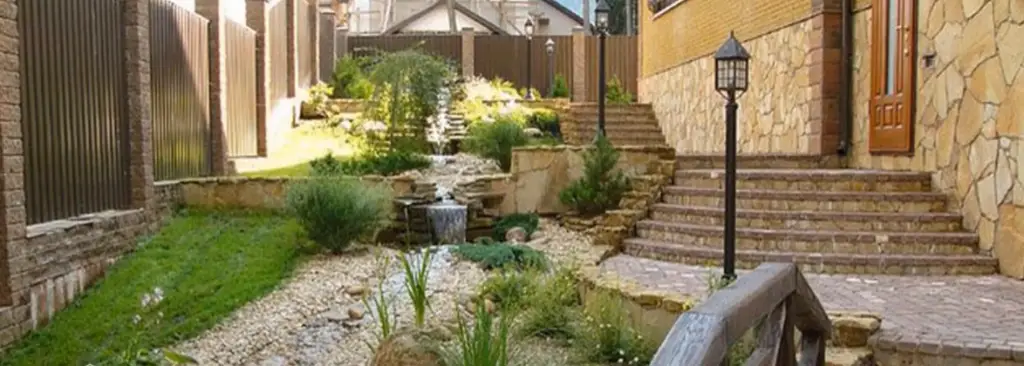
What kind of landscaping can I do on a steep slope?
When landscaping on a steep slope, it’s important to plan ahead and choose features that will be both functional and aesthetically pleasing. Terracing with retaining walls or using native plants for erosion control can help reduce runoff while also providing an attractive look. Another option is installing pathways or steps to provide easy access up and down the incline. Finally, adding hardscape elements such as decks or patios can provide a level surface that allows for comfortable outdoor entertaining. Overall, it is important to consider both form and function when deciding on the right solution for your project.
How do you decorate a small sloped backyard?
There are many creative ways to decorate a small sloped backyard with the right materials and thoughtful design. For example, you could use stone steps or pathways to help create an attractive transition from one level of the yard to another. Additionally, incorporating raised planters can be a great way to bring color and texture into the space while also providing an area for planting flowers or vegetables. If you have more room, installing a patio or deck at ground level can provide additional seating areas and make it easy to enjoy the outdoors in comfort. Finally, adding decorative elements such as lights, sculptures, or art pieces can enhance the overall look of your small sloped backyard.
How do you landscape a steep slope without retaining walls?
When landscaping a steep slope without retaining walls, it is important to choose plants that are adapted to the environment and require minimal maintenance. Native plants work well for this type of situation as they can help reduce erosion and withstand harsh weather conditions. Additionally, ground covers such as sedums or grasses can be used to create a living mulch that will both slow down runoff and add visual interest to the landscape. Finally, installing pathways or steps can provide an easy way up and down the incline while still allowing room for planting in certain areas.
How do you support a sloping garden?
Supporting a sloping garden can be achieved by using terracing with retaining walls or installing steps to provide easy access up and down the incline. Additionally, using native plants that are adapted to soil composition and climate conditions in your area can help reduce runoff and erosion while also providing attractive ground cover for your landscape design. Finally, it is important to consider drainage when planting on a slope as good drainage will allow water and nutrients to reach the roots of the plants without pooling at the base of the hill.
How do I level my backyard slope?
Leveling a backyard slope can be accomplished using several methods depending on the size and type of slope. For smaller slopes, terracing with retaining walls or raised beds may be an option. Additionally, installing steps or pathways up and down the incline can provide easy access while also creating attractive transitions between levels in the yard. If you have more room, adding a patio or deck at ground level is another solution that will provide a comfortable space for outdoor entertaining. Finally, if all else fails, grading and leveling the area with soil is always an option to create an even surface without the need for additional structures.
How much does it cost to create a sloping garden?
The cost of creating a sloping garden depends on the size and complexity of the project. Generally, installing retaining walls or terracing can be expensive, with costs ranging from several hundred to several thousand dollars depending on the materials used. Additionally, adding pathways or steps may require additional labor costs if they are not DIY-friendly. Finally, planting native plants adapted to your local soil composition can help reduce maintenance costs in the long run while also providing an attractive look.
In general, it is important to consider both form and function when determining the best solution for your project when budgeting for a sloping garden. On average creating a sloping garden can cost anywhere from a few hundred to several thousand dollars.
What is the least expensive retaining wall?
The least expensive retaining wall option is typically a dry stack stone wall. Dry stack stone walls are constructed with stones stacked on top of each other, without the use of mortar. This type of wall can provide an attractive and functional boundary while also remaining cost-effective to build and maintain. Additionally, if you have the time and skill, dry stack stone walls can be built as a DIY project, further reducing costs. For larger projects, however, poured concrete or interlocking block retaining walls may offer better stability and longevity for your investment. Ultimately, the best choice will depend on your budget and desired outcome.
Useful Video: 30 Best Sloped Backyard Ideas On a Budget
Conclusion
Sloped Gardens provide many benefits to gardeners and homeowners alike. They can be aesthetically pleasing and add a unique dimension to any outdoor space. Additionally, they improve drainage, reduce erosion, conserve water, and help create microclimates that may benefit certain types of plants. While there are certainly some challenges associated with creating a sloped garden, it is more than possible to design a beautiful outdoor area with the right planning and preparation. With thoughtful planning and careful installation, anyone can create an attractive sloped garden perfect for their needs.
References:
- https://papillonlandscape.co.uk/sloping-garden/
- https://www.fallsgarden.com/sloped-backyard-ideas-on-budget/
- https://www.idealhome.co.uk/garden/garden-ideas/sloping-garden-ideas-275474





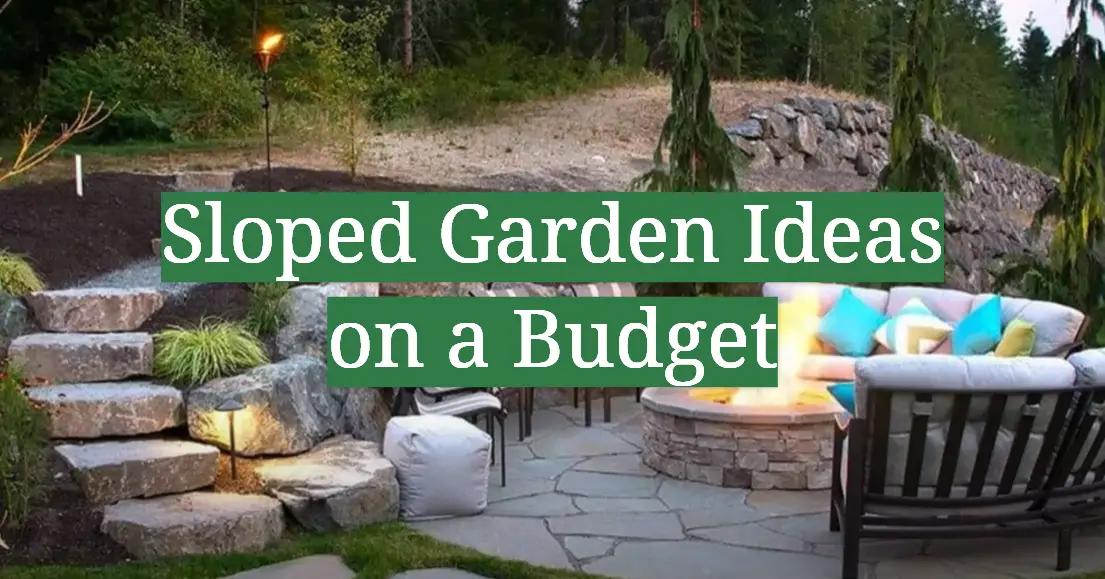




Leave a Reply
View Comments